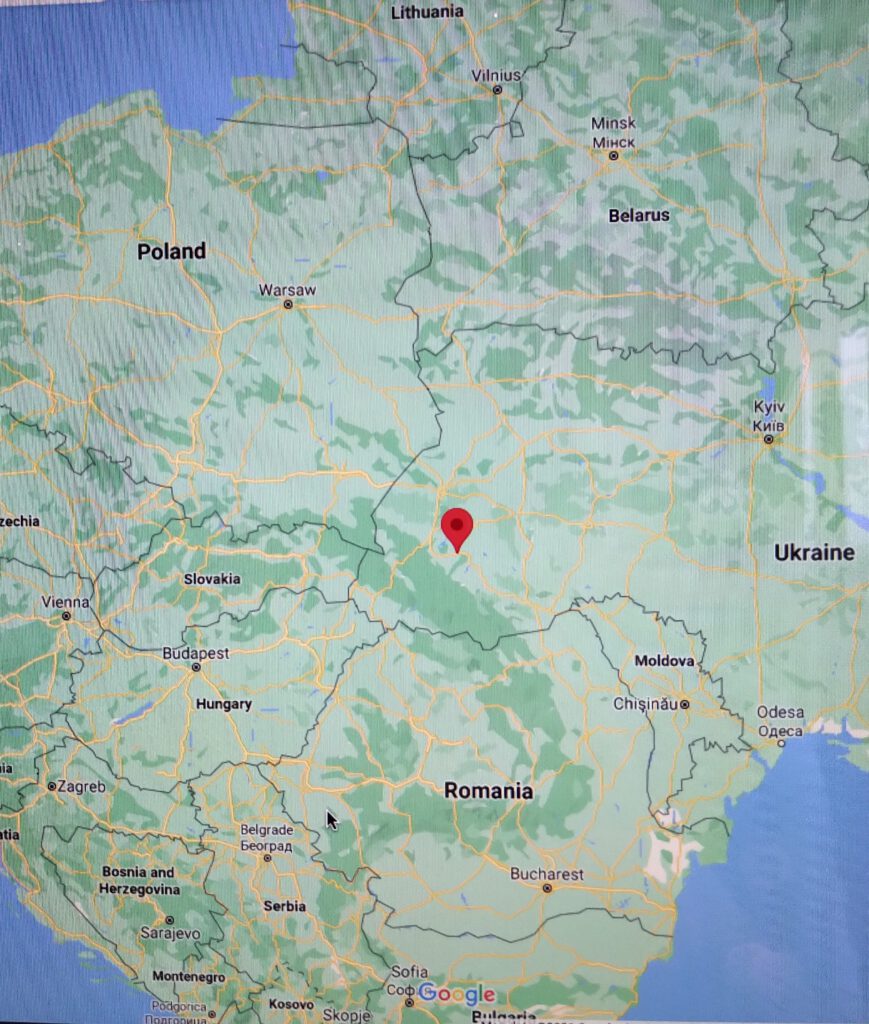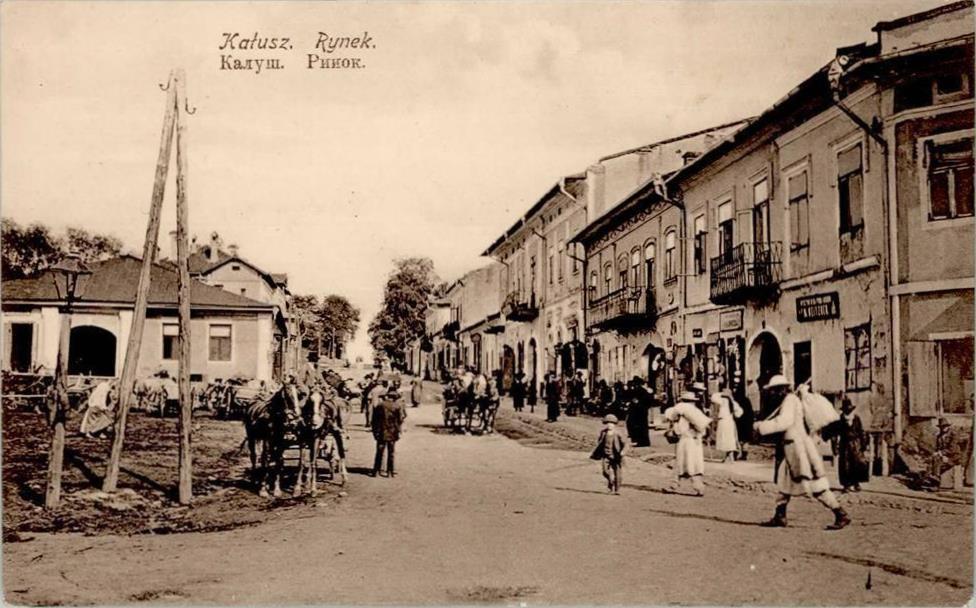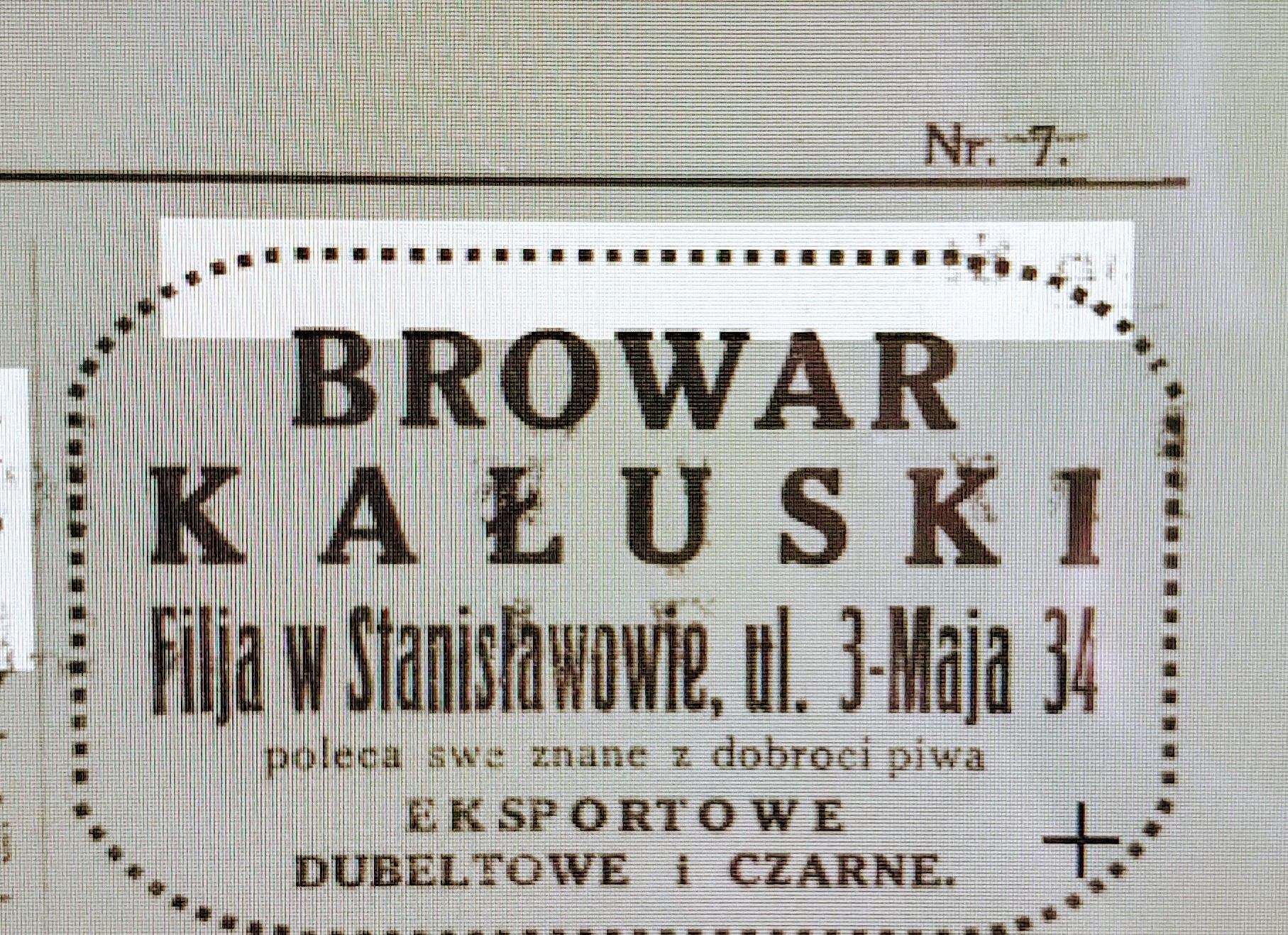Jews of old Kalush
I have been discussing Jewish-owned breweries in pre-war Central and East Europe. There were quite a few, of different sizes.
One was in Kalush, as it is now called, a city in Western Ukraine, but first some notes on Jewish families and commerce in the city, as it was then.
The Geni site offers a crisp outline, stating:
KALUSH (Pol. Kalusz), city in Ivano-Frankovsk (Stanislavov) district in southwestern Ukraine, formerly within Poland; in 1772 it passed to Austria, reverting to Poland in 1919, and was within the U.S.S.R. from 1939 to 1991 when Ukraine gained independence.
The Kalush entry at Google Maps indicates the location, in the Carpathian foothills (via Google Maps):
“Austria” before World War I denoted the Hapsburg Empire, aka the Dual Monarchy, which foundered in defeat in 1918. Kalush was in Galicia, a province of the Empire just as Czechia (Bohemia) was although it would stretch a point to say Galician lager shared the fame of Bohemia’s.
In 19th century Kalush, Jews traded in salt, lumber, and hides, and were active in industry, education, and the professions. They built many synagogues and schools. From a majority in 1880, the city’s Jewish component declined to a still-substantial one-third in 1939.
The loss was due in good part to severe depredations by Russian troops during World War I. Yet, nothing would match the Nazi ferocity that killed almost every Jewish man, woman and child in Kalush by 1943.
An image in Wikipedia Commons shows the Kalush market square before 1914:
If there was a golden time for the Jewish people in Kalush, it was then. Certainly the town’s brewery reached its apogee in Emperor Franz Joseph I’s Galicia.
Memories of the Brewery
A Holocaust survivor raised in Kalush, Tsufyah Shpilmen, recalled pleasant days in the compound of the brewery. The family’s home was there, due to her father’s position with the firm.
Shpilmen recounted her girlhood memories for the Kalush Yizkor (memorial) volume published in Israel in 1980. Portions are reproduced in the JewishGen site, where I found them. The site memorializes vanished pre-war Jewish life in Europe.
She wrote (translation by Deborah Schultz):
Before I left Kalush, our family lived in “Browar,” the beer brewery. There Father worked as a directorate official. After our house was destroyed by fire in the First World War, we received an apartment in the domain of the factory. The two owners, Aba Milshtein and Leibtshah Shpindel, I see in my imagination as if they were standing before me. The chief and older of them had grey hair. They were both always wearing black suits; in their hands, Tyrolean walking sticks. When they grew very old, administration of the factory passed to their children: Zelig Milshtein and his son Mosheleh, and Leibtshah’s grandson, Shlomoh.
And further:
… Kalush, the town of my birth, the place where all my dear ones were destroyed, will not pull out of my memory. My heart is gripped each time I think about what happened there.
Remarkably, a period image on Facebook shows one of the owners she so vividly recalled, carrying his Tyrolean walking stick.
The image appears at 1:14-1:15 in a video uploaded to its Facebook page by the brewery.
The brewery still exists, in other words.
See middle video, second row, under “All Videos”. The brewery this man did much to create is now called Kalush Brewery.
Some Brewery History
Creditably, the brewery has posted a fairly detailed history on its website. In part it states (Google translation):
1870 The owners of the Kalusha brewery and distillery were private individuals – the Milstein, Schlinder and Weissman families, who owned the brewery until the beginning of World War II. They improved the equipment at the brewery and significantly increased the production of low-alcohol beverages. About 150 workers from local burghers, mostly residents of the villages of Khotyn and Pidhirka, as well as Zahirya, worked at the prestigious enterprise. According to statistics, more than 20,000 hectoliters of good quality beer were produced here annually. If necessary, the plant could double the production of low-alcohol beverage and increase its production to 45 thousand hectoliters. The brewery owned its own houses, had beer warehouses and a turbine for 100 horsepower …
Brewing occurred onsite even earlier, 1565 is now taken as the earliest year for this, but the real growth and expansion dates from 1870.
Apart the brewery’s Facebook page, further historical information is set out in this Ukraine webpage, a clearing house for Ukraine brewing information.
A short account of the brewery in the Sztetl memorial site adds that ahead of World War I, production reached some 40,000 hl per year.
By comparison, an enterprise such as Poland’s Okocim Brewery, well-known then and now, was much larger: in 1911 it produced 380,000 hl per annum.
The Kalush brewery was in a different category, a successful but smaller-size, regional concern, which mainly supplied its area and contributed to the local economy.
In 1890 the owners added a maltings, which is still used today.
Before World War II the brewery was called Mühlstein, Spindel & Weissman. Weissman died in 1915 and the others continued. The owners’ names are variously spelled in different sources, but there is no doubt of the persons intended.
Tsufya Shpilmen refers in her account to the brewery turbine, which allowed homes on the compound to have electric light and hot water. These were luxuries then, the town as a whole was not electrified until some years later.
The brewery suspended activity during the First World War but recommenced operations between the wars. In 1934 it advertised in the Echo, a Polish weekly published in Stanislawow, another town in Galicia. The brewery had a presence there, perhaps a warehouse.
Export, Dubbel, and Czarne (likely porter-style) beers are shown above, a range typical of many breweries in Poland and further East before 1939.
The excellent Polish Beer Labels site includes a fine set of interwar labels. As well, an early brewery label is shown in the Sztetl site, with a sample invoice.
The fate of the pre-1939 principals is not mentioned in these sources, or others to my knowledge. It seems unlikely they survived the Holocaust, but I don’t know for certain.
The Modern Brewery
Today, the brewery makes a wide range including a craft line. Some of the old names continue, Export for example. Indeed there is a range of Export labels, atmospheric and cleverly named.
“Export to Lviv”, “Export to Riga”, and “Export to Leningrad” have been among them. This one, for Riga (image via Colnect), bears a carp symbol, an apt symbol of Mitteleuropa:
The brewery’s labels and artwork show sophistication of design and execution. Further examples can be seen in the Ukraine sources cited in these notes.
In another video posted by the brewery to Facebook, the words “In Galicia” appear after the brewery name – a conscious attempt to link to the past.
The brewery is independently owned by interests based in Kyiv, Ukraine, formerly Kiev. Currently a Kalush-based management company operates the brewery for the owner.
The owner modernized and upgraded the plant after acquiring the site in 2012. Details are described in the website of the Ukraine solicitors who assisted with the purchase.
New equipment was installed, including apparently the cylindro-conical fermenters shown. Yet, the pitched-roof building exteriors seem much the same as 100 years ago.
All beer is carbonated naturally with aging of between 25 and 60 days, according to this source mentioned above.
The Jewish Past
In Kalush today there is some interest to know the history of the brewery, and of long-disappeared Jewry in the city.
In November 2017 journalist Marta Onyskiv of Kalush News recalled this past in a short but affecting piece, enhanced by evocative images. It mentions some of the brewery history, even the Shpilmen account.
Some observers consider that in Ukraine, and elsewhere in East Europe today, a kind of historical amnesia attends the former significant Jewish presence and its importance there. The Kalush News article is perhaps a harbinger of change in this regard.
Note re images: the source of each image is linked in the text above. All intellectual property therein belongs solely to the lawful owner, as applicable. Images used for educational and research purposes. All feedback welcomed.





The countryside in Ukraine near Kalush is like another world. In 2012, we hired a driver to take us to a small village where my wife’s mother’s family had lived, about 40 km from Kalush. There we ran across an old family neighbor who asked us in for lunch. She had no indoor plumbing, and hand pumped her well water. She offered eggs that she retrieved from her chicken coop. Horse carts were common on the road. A school girl, talking on her cellphone, herded cows down the road from pasture to their owners’ yards for the night.
Your last comment about the general lack of acknowledgement of Jewish history in Ukraine agrees with my impression. However, on a walking tour of Lviv, our guide did point out the site of the destroyed Golden Rose Synagogue. Also, when we had desserts in the restaurant of the Lviv Split casino we were surrounded by historical photos featuring Jewish life.
Really interesting to have these impressions of an actual visit to the area, and knowing the people and language, thanks for this.
Good to hear of the Jewish memorial references. My sense is more and more this is happening, and it comes (from what I understand) largely from within. I think people do want to know about this past and have more opportunities now to learn, vs. in the Soviet period.
It’s a long-term process but some progress is being made, following similar example in Poland, again from what I’ve learned.
There was an initiative in recent years in Kalush (locally by people there) to tidy the Jewish cemetery for example.
There has to be some acknowledgement of Jewish presence and history in Ukraine. Pres. Zelensky is ethnic Jewish. The oligarch Ihor Kolomoisky, associated with Zelensky through the TV show “Servant of the People”, is actively involved in Ukrainian Jewish affairs.
This helps.
There are many articles that have analysed this issue. Some are rather pessimistic, some go the other way. People can form their own views, I feel cautiously optimistic based on what I’ve read about Kalush anyway.
Certainly the brewery’s own acknowledgement of its history, as I have noted in the post, is a positive sign.
Great photograph, and a very interesting series.
I wasn’t aware of the Jewish brewing heritage at all until this series ran, and I wouldn’t have thought it extensive. I see that in fact its very extensive.
I’ve also been surprised by the brewing in those regions covered by this series that were inside of Russian domains, as I don’t associate that (vast) region of the globe with brewing at all.
Thanks for this. My studies, which are still ongoing, suggest little involvement in brewing (comparatively) in Central and West Europe, and by extension North America. I’ve been focusing too on pre-craft.
Eastern Europe has proved different, where there was definitely a tradition, in part connected to the liquor trades generally and Propination in Galicia. It was generally at the mid- to small-level of ownership, and was declining by WW I, but there was definitely involvement in the sector.
I’ve got more coming. In the context of this kind of writing, vs. a book or monograph, I’m trying to present different parts of the picture: different-size breweries and geographic areas, cases where women owned breweries, etc. – a kind of bird’s eye view.
For Russia and the lands formerly in its Empire now independent, European brewing did implant from the mid-1800s and in some cases even earlier. It was a similar trend to what happened in Central and West Europe but took longer to occur.
Russia had the kvass tradition (still does), and vodka also a strong tradition, so partly that too delayed I think a full-blown brewing industry a la UK or Germany say, but in time it acquired breweries much the same as in those places.
The other factor for Russia of course, and other parts of the East, was delayed or incomplete industrialization. The Communist takeover then further delayed it for the next two generations.